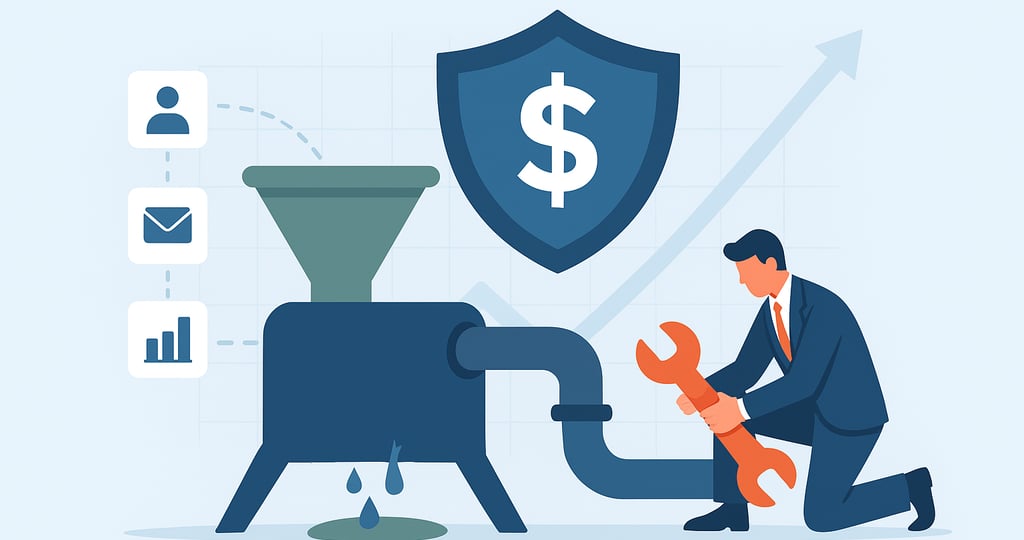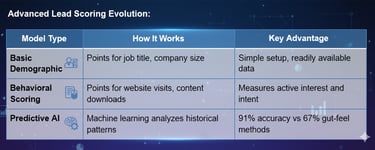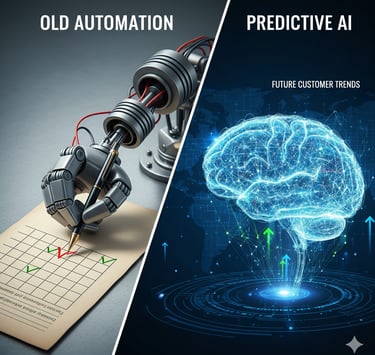Why Your Sales Automation is Leaking Revenue (And How to Fix It)
SAASGROWTH
9/4/20257 min read


Key Takeaways
The 70% Failure Rate: Only 30% of sales teams achieve expected ROI from automation tools. The rest pay premium prices to scale dysfunction faster.
Strategy Before Software: Most failures happen when companies automate broken processes instead of fixing the foundation first.
Data Quality Crisis: Poor data costs organizations $12.9M annually. Clean data isn't optional—it's the fuel that determines automation success.
Revenue-First Metrics: Success requires tracking CAC, LTV, and pipeline velocity instead of vanity metrics like email opens.
Human + AI Strategy: Win by combining intelligent automation for admin tasks with enhanced human capability for relationship building.
Your automation dashboard glows green. Lead volume is up 40%. Email open rates hit 25%. Marketing celebrates another "successful" campaign.
But your P&L tells a different story. Revenue growth is flat. Pipeline quality is declining. Your sales team drowns in unqualified prospects.
You're experiencing the Automation Paradox: sophisticated technology creating less sophisticated results.
What's Really Causing Your Sales Automation to Fail?
The answer isn't what most Growth Partners want you to hear.
Today's automation platforms work perfectly. They're sophisticated, feature-rich, and technically capable. The failure is strategic, not technological.
Most companies automate the wrong things, in the wrong sequence, for the wrong reasons. They take broken manual processes and make them consistently broken at an industrial scale.
Think about it: if your manual lead qualification process misidentifies prospects, what happens when you automate it? You deliver bad leads faster and more efficiently than ever.


Are You Making These Four Critical Revenue-Draining Mistakes?
1. Do You Let Features Drive Your Strategy?
The most expensive automation mistake is letting platform capabilities dictate your business strategy.
Most implementations start wrong. Teams ask "What can this tool do?" instead of "What specific business problem are we solving?"
Without measurable objectives – like reducing lead response time by 50% or increasing MQL-to-SQL conversion by 15% – you end up using features because they exist. Not because they drive results.
What we see in RevOps: Marketing celebrates lead volume increases while sales complain about quality decreases. Automation amplifies this misalignment by generating more wrong activities faster.
The hidden cost? Your teams operate with completely different success definitions. Marketing optimizes for lead quantity while sales needs lead quality.


2. Is Your Data Contaminating Every Automated Decision?
Your automation platform is only as intelligent as the data feeding it. Bad data makes every automated decision unreliable.
The contamination scale is staggering:
20% annual decay in corporate email lists as contacts change roles
65% of sales professionals don't trust their own company's data
$12.9 million average cost per organization from poor data quality
The "1-10-100 Rule" reveals the real damage:
$1 to verify data at entry
$10 to clean it later
$100 per record if you operate on bad information
The vicious cycle: Bad database → High bounce rates → Damaged sender reputation → Spam folder placement → Lower engagement → Worse data quality → Repeat.
Each cycle makes recovery harder and more expensive.


3. Are You Using Automation to Kill Human Connection?
77% of B2B buyers won't engage with brands lacking personalization. Yet most companies use automation to create generic, robotic interactions.
The fundamental error? Using automation to replace personalization instead of enabling it at scale.
Instead of automating administrative tasks so humans focus on genuine connection, organizations automate the human connection itself.
Real-world example: Imagine receiving a "personalized" email that mentions your wrong company name. That prospect doesn't just delete it, they form lasting negative associations with your brand.
The true cost: Not just one lost opportunity, but forfeiture of that prospect's entire lifetime value plus their referral network.
Research shows that 80% of sales require at least five follow-up touchpoints, but 44% of reps give up after just one attempt. Automation should solve this persistence gap with intelligent, relevant messaging not generic spam.


4. Is Your Tech Stack Creating More Friction Than Flow?
Disconnected tools don't create efficiency; they create administrative overhead that consumes 60% of your team's time.
When your CRM, marketing automation, sales intelligence, and communication systems don't integrate seamlessly, teams spend more time managing technology than leveraging it.
What this looks like: Critical leads fall between system cracks. Follow-ups get delayed. Customer interactions become embarrassingly inconsistent.
The integration tax: Every disconnected system imposes cognitive overhead on every sales activity. Your team becomes technology managers instead of revenue generators.
How Much Revenue Are You Actually Losing?
Let's quantify the damage with real numbers.
Conservative Model: Mid-Sized B2B Company
10,000 annual leads with 10% leakage = 1,000 lost leads
1,000 lost leads × 21% conversion = 210 lost opportunities
210 lost opportunities × 22% close rate = 46 lost deals
46 lost deals × $50,000 ACV = $2.3 million leaked revenue
This doesn't include:
Customer lifetime value from renewals and expansions
Referral opportunities from satisfied customers
Competitive advantages lost to more efficient competitors
Team productivity costs from system friction
Real example: A leading automotive company was losing $9 million annually due to duplicate invoices and manual data entry errors. Automated anomaly detection prevented $5 million in revenue leakages with 95% automation in their ERP posting process.
Stop the leaks before they cost you millions, get BriskFab’s quick automation audit today.
How Do You Stop the Revenue Bleeding? The 3-Pillar Fix
Pillar 1: Can You Fix Your Foundation Before Adding Features?
Before deploying automation, audit and redesign using this methodology:
Map → Chart how work actually gets done (not how it should work in theory)
Analyze → Find redundant approvals, manual transfers between systems, bottlenecks where work stalls
Redesign → Eliminate weaknesses systematically before automation touches them
Data integrity requirements:
Mandatory CRM fields for all new records
Quarterly data cleanup initiatives
Automated enrichment tools for real-time validation and completeness
Critical alignment: Sales and marketing must agree on unified KPIs and formal Service Level Agreements that provide data-driven definitions of qualified leads.
What we've seen work: Companies using single, integrated CRM and marketing automation platforms eliminate data silos and ensure seamless customer journeys from first touch to final sale.
Pillar 2: Are You Deploying Intelligence or Just Automation?
First, Validate Before You Automate: Test and verify your processes work manually before scaling them. A broken automated process is just broken faster and more expensively.
Once Validated - Strategic Automation Approach:
Automate: Data entry, scheduling, workflow routing
Human-in-the-loop: Customer-facing interactions, complex decisions, relationship building
Enhance: Strategic decision-making with AI insights


Pillar 3: How Do You Ensure Long-Term Success?
Success requires disciplined change management and continuous optimization:
Continuous Learning Systems:
Replace one-time training with ongoing skill development
Use AI-powered role-play simulations and gamified learning experiences
Build lasting behavioral changes through habit formation
Governance Protocols:
Bi-annual workflow audits to identify new bottlenecks
Regular data quality assessments and cleanup initiatives
Formal feedback loops for continuous process improvements
What Metrics Actually Predict Revenue Success?
Traditional Automation Metrics (Activity Focus):
Impressions & reach → Eyeballs, not revenue
Clicks & traffic → Attention without action
MQLs → Interest, often not sales-ready
Revenue-First Metrics (Outcome Focus):
CAC → Cost to acquire paying customers
LTV → Revenue per customer lifetime
LTV:CAC Ratio → Industry benchmark 3:1+ for scalable growth
Net Revenue Retention (NRR) → Customer expansion and retention health
What we've seen in practice: Companies tracking revenue-focused metrics outperform activity-focused competitors by 2.3x in sustainable growth rates.
What's the Future of Sales Automation?
The next evolution moves from task execution to predictive insight generation.
Predictive capabilities emerging:
Deal forecasting with 91% accuracy vs. 67% gut-feel methods
Customer behavior anticipation based on engagement patterns
Proactive resource allocation and strategic intervention
Generative AI could add $2.6-4.4 trillion in annual value to the global economy, with significant portions unlocked in sales and marketing functions.


The Bottom Line: Strategy Before Software
Sales automation isn't failing because technology is inadequate. It's failing because implementations lack a strategic foundation, process discipline, and measurement sophistication.
The path forward: Treat automation as a strategic capability, not a technology purchase.
Companies recognizing this distinction and investing systematically will dominate markets. Those treating automation as plug-and-play will fund their competitors' growth.
The choice is yours. Will you fix the leaks or keep paying premium prices to fail faster?
Ready to see where your automation is bleeding money? Get BriskFab's Revenue Engine Mini-Audit – we'll map your funnel, score your automation health, and identify the top 3 fixes that could unlock your next 20% revenue lift.
Frequently Asked Questions
1. How quickly can I see results from fixing automation leaks?
Initial process improvements and data cleanup show impact within 30-60 days. Compound benefits emerge over 4-6 months as workflows stabilize and teams adapt to optimized processes.
2. Can small businesses use this framework, or is it just for enterprises?
The principles scale to any organization size. Smaller businesses have advantages—fewer legacy systems, faster decision-making, more agile process changes. The key is proportional investment based on business complexity.
3. What's the difference between marketing and sales automation in this context?
The distinction is artificial for revenue generation. Modern buyers expect seamless experiences across touchpoints. This framework treats marketing and sales as unified revenue engine components rather than separate functional areas.
4. How do I measure ROI on process improvements vs. technology investments?
Track leading indicators (data quality scores, process completion times, lead handoff success rates) alongside lagging indicators (revenue attribution, CAC, pipeline velocity). Process improvements typically show efficiency gains before revenue increases appear.
5. Should I fix existing automation or start fresh with new platforms?
This depends on foundation quality. If core processes are sound and data is clean, optimizing existing tools is usually more cost-effective. If foundational problems are severe, starting fresh often provides better long-term ROI despite higher initial investment.
6. What's the biggest mistake companies make when implementing this framework?
Skipping Pillar 1. Companies want to jump straight to advanced AI and automation features without fixing their foundational processes and data quality. This creates expensive, sophisticated systems that scale broken workflows faster.


